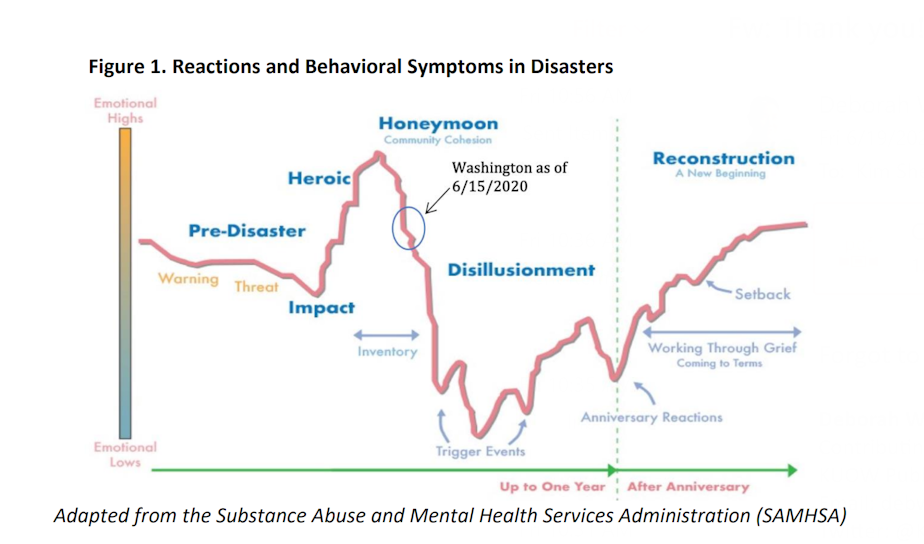The honeymoon’s over: Welcome to the disillusionment stage of Covid-19

People in Washington state are likely to see a worsening of their behavioral health throughout the rest of the year because of Covid-19.
That’s according to a June behavioral health forecast from the state’s Department of Health. It relies heavily on research on how people have responded to previous disasters and pandemics.
According to the report, the pandemic and lock-down have caused a “surge in behavioral health symptoms” across the state. They include elevated rates of depression, anxiety, post-traumatic stress disorder and insomnia mostly caused by experiences of isolation and quarantine.
Emergency room visits for psychological distress have been steadily rising in the weeks since the lock-down began.
Health officials are also concerned about an increase in substance use and misuse. Alcohol and drug related emergency room visits were up in May. That coincides with a roughly 38% increase in marijuana and liquor sales.
Calls to the state’s tobacco quit line are also down 41%, indicating that people are postponing attempts to stop smoking.
Sponsored
“We know that substance abuse is increasing, and we know that is a typical thing in disaster patterns, that’s a typical thing for this phase. People are looking for ways to cope and are looking for anything familiar to them,” said Dr. Kira Mauseth, a clinical psychologist and one of the authors of the report.
Another problem that is typical in previous pandemics: according to the Washington Association of Sheriff's and Police Chiefs, domestic violence offenses are up about 17 percent higher than the same time last year.
H
ealth officials say during a disaster or pandemic, people’s psychological responses follow a predictable pattern.
As the pandemic approaches, there is a period of worry and anxiety. After it hits, there is a brief honeymoon period as people come together to fight it. That can manifest in an outpouring of altruism, and creative thinking about how to respond.
Sponsored
That’s considered the heroic stage of the disaster.
Now, health officials say we have entered a next phase—a long, slow descent into disillusionment, that usually begins 3-6 months after the crisis. That’s when depression often deepens.
“The depression experience comes from the realization that in part there is no return to normal in terms of the way things were before the pandemic. So it’s just a difficult transition and adjustment for people to make,” said Dr. Mauseth.
In the disillusionment phase, suicide risk is at its highest.
The report suggests that between two and three million people in Washington state will experience significant behavioral health symptoms over the next 3-6 months.
Sponsored
Over the summer, the report’s authors caution that people should be on the lookout for symptoms like anxiety, increased frustration and aggression, substance use, trouble sleeping, stomachaches and headaches.
Health officials should be working to increase community supports and build resilience, while preparing people for the possibility of multiple pandemic waves.
The report's authors expect people to return to some normal level of functioning after about 12-14 months. That’s assuming there isn’t a second or third wave of the virus.




